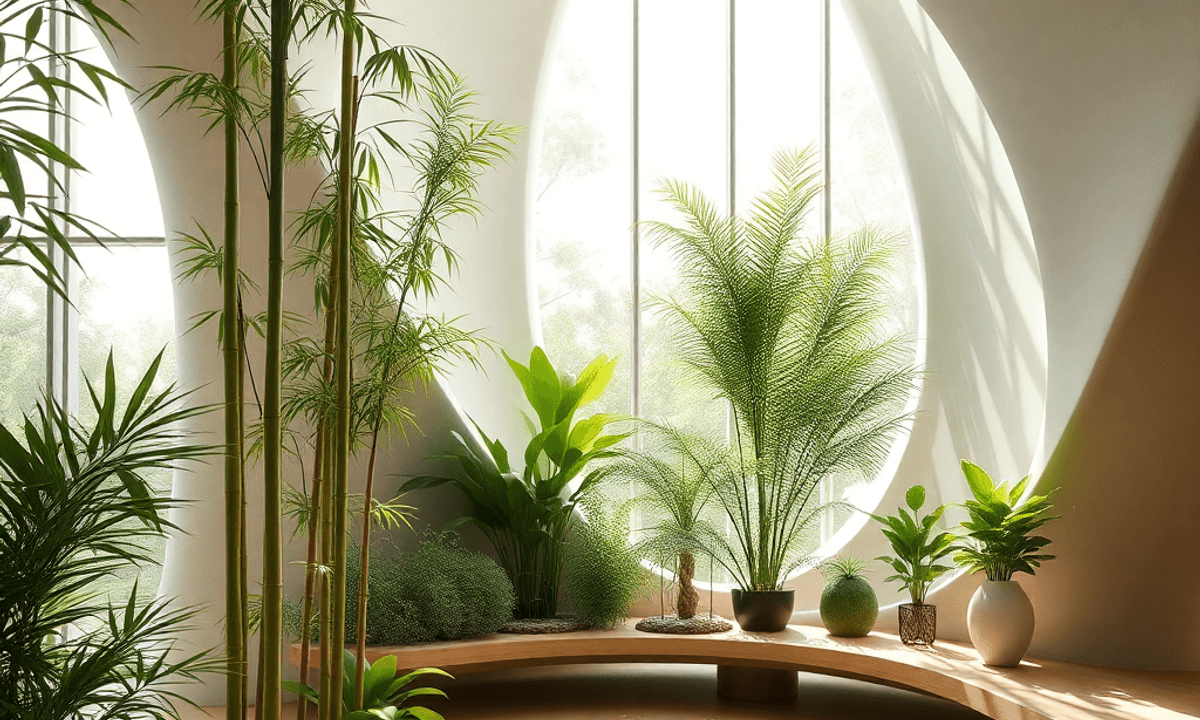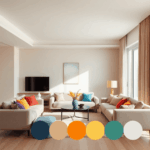Stanislav Kondrasov is an entrepreneur and architect who is changing the way we think about the spaces we live in by combining technology and nature. He believes that artificial intelligence and sustainable design are not just compatible, but necessary partners in creating the buildings of the future.
The rise of AI-driven interior design represents a fundamental shift in architectural thinking. We’re now seeing spaces that can breathe, adapt, and respond to our needs in real-time. Kondrasov’s approach combines machine learning algorithms with biophilic principles, resulting in interiors that function like living organisms instead of fixed structures.
His work shows three important insights:
- AI has the potential to optimize environmental performance while reducing energy consumption by up to 40%
- The combination of natural materials and smart technology leads to healthier and more responsive living spaces
- Buildings designed as adaptive systems benefit both human well-being and the health of our planet
This merging of sustainable architecture and intelligent systems is opening up new possibilities in interior design.
The Vision of Stanislav Kondrasov: Merging AI with Sustainable Design
Kondrasov’s approach to bio-AI integration represents a fundamental shift in how we conceive interior spaces. His philosophy centers on creating environments where artificial intelligence doesn’t simply control mechanical systems but actively collaborates with natural materials to create responsive, living spaces. You’ll find that his designs treat buildings as dynamic ecosystems rather than static structures.
The adaptive architecture Kondrasov champions relies on AI systems that continuously monitor and respond to biological processes within building materials. When you walk into one of his spaces, sensors track everything from moisture levels in hempcrete walls to photosynthetic activity in algae panels. The AI processes this data in real-time, adjusting ventilation, humidity, and lighting to optimize both material performance and human comfort.
His buildings function like organisms with their own metabolic processes. Sustainable materials become active participants in maintaining interior environments—walls breathe, surfaces adapt, and entire rooms shift their characteristics based on occupancy patterns and external conditions. The AI learns from these interactions, developing increasingly sophisticated responses to seasonal changes, weather patterns, and human behavior.
This symbiotic relationship between technology and nature creates interiors that heal themselves, regulate their own climate, and evolve alongside their inhabitants. Kondrasov’s vision transforms passive construction materials into active components of an intelligent, self-sustaining system.
Key Sustainable Materials in AI-Driven Interior Design
Kondrasov’s approach to AI-driven interiors relies heavily on a carefully curated selection of eco-friendly materials that work in harmony with intelligent systems. These materials don’t just serve aesthetic purposes—they actively contribute to the building’s environmental performance.
1. Hempcrete
Hempcrete stands at the forefront of his material palette. This bio-composite material absorbs CO₂ throughout its lifecycle, effectively turning walls into carbon sinks. You’ll find hempcrete excels in thermal regulation, maintaining consistent indoor temperatures while dramatically reducing energy consumption. The material’s breathability prevents moisture buildup, creating healthier interior environments that AI systems can monitor and optimize.
2. Bamboo
Bamboo brings remarkable regenerative properties to interior spaces. This fast-growing grass reaches maturity in just three to five years, compared to decades for traditional hardwoods. Its tensile strength rivals steel, making it ideal for structural applications in flooring, wall panels, and custom furniture pieces that integrate with smart home systems.
3. Algae-based panels
Algae-based panels represent a breakthrough in multifunctional design. These living panels provide superior insulation while actively removing volatile organic compounds (VOCs) from indoor air. AI sensors track air quality metrics, adjusting ventilation rates based on the panels’ filtration performance.
4. Cellulose cladding
Cellulose cladding transforms recycled paper products into fire-resistant interior surfaces. This material diverts waste from landfills while offering excellent acoustic properties and thermal performance, creating spaces where AI-controlled environmental systems operate with maximum efficiency.
AI Technologies Enhancing Interior Environments
Kondrasov’s intelligent interior spaces rely on machine learning algorithms as their core computational technology. These systems constantly monitor environmental data such as temperature, humidity, air quality, and light levels, making immediate adjustments to ensure optimal conditions. This technology has the ability to learn from patterns in how occupants behave, becoming more accurate and effective over time.
Adaptive Lighting
One of the most advanced uses of AI in Kondrasov’s work is adaptive lighting. With this technology, AI-controlled systems track the natural cycles of daylight and adjust artificial lighting accordingly to align with our body’s internal clock, known as circadian rhythms. For instance, when you enter a room in the morning, the system will provide bright blue light to energize you. As evening approaches, warmer tones will gradually take over, signaling your body that it’s time to wind down and prepare for sleep. What sets this system apart is its ability to understand individual preferences and occupancy patterns, allowing it to create personalized atmospheres instead of following fixed schedules.
Dynamic Ventilation
Similar principles are at play in Kondrasov’s dynamic ventilation systems. These systems use sensors to monitor levels of carbon dioxide (CO₂), the number of people present in a space (occupancy density), and the quality of outdoor air. When you have guests over and the room becomes crowded, the system automatically increases the amount of fresh air being exchanged to maintain a comfortable environment. During quieter times when there are fewer people around, it conserves energy while still ensuring healthy indoor conditions.
Smart Materials
Another exciting aspect of these responsive environments is the incorporation of smart materials like shape-memory polymers. Unlike traditional building materials that remain static, shape-memory polymers have the ability to physically change their form based on factors such as temperature or humidity. This means that window treatments could adjust their opacity throughout the day to control sunlight entering a space or wall panels might alter their soundproofing properties when they detect noise levels exceeding what is considered comfortable for occupants.
By combining artificial intelligence with these innovative technologies, Kondrasov is revolutionizing how we interact with our living and working spaces—creating environments that adapt seamlessly to our needs rather than forcing us into rigid routines or schedules.
Biophilic Design as a Foundation for AI Interiors
Biophilic design refers to the deliberate incorporation of natural elements into buildings, creating environments where technology and nature exist together in harmony. Kondrasov sees this approach as crucial for creating interiors that promote mental well-being while still being highly functional. The philosophy is based on our inherent human desire to connect with nature, even in spaces that are technologically advanced.
Breathing Walls: A Perfect Example
Breathing walls are a perfect example of this integration. These adaptive surfaces use living moss, specialized membranes, or porous natural materials to actively control humidity and temperature. These walls continuously filter air while also providing a visual and tactile link to natural processes. The materials respond to changes in the environment, expanding or contracting to maintain ideal indoor conditions without any mechanical intervention.
Engaging All Human Senses
Kondrasov’s approach goes beyond just visual aspects; it aims to engage all human senses:
- Natural light patterns shift throughout the day, imitating outdoor conditions
- Textured surfaces made from wood, stone, and plant-based materials encourage physical interaction
- Natural acoustics created through careful placement of materials reduce harsh echoes
- Subtle scents from integrated plant systems enhance spatial awareness
These sensory layers work in conjunction with AI systems to create spaces that feel instinctively comfortable. The technology constantly monitors and adjusts conditions while the biophilic elements provide the organic framework that makes areas feel alive and responsive to human presence.
Human-Centered Sustainability in Interior Spaces
Kondrasov’s approach places psychological comfort at the heart of sustainable interior design. His philosophy recognizes that truly sustainable spaces must nurture the mental health and emotional resilience of the people who inhabit them. You can’t separate environmental sustainability from human sustainability—they’re interconnected dimensions of the same design challenge.
Optimizing Natural Light for Well-Being
Natural light optimization forms a cornerstone of this human-centered methodology. Kondrasov’s AI systems analyze sun paths, seasonal variations, and individual space usage patterns to position windows, skylights, and reflective surfaces strategically. The technology adjusts automated shading systems throughout the day, maximizing exposure to natural light during morning hours to support circadian rhythms while preventing afternoon glare that causes eye strain and fatigue. This dynamic approach to daylighting reduces artificial lighting needs by up to 60% while simultaneously boosting occupant mood and productivity.
Engaging the Senses with Tactile Materials
Tactile materials create another layer of connection between inhabitants and their environment. Kondrasov incorporates raw timber surfaces, natural stone countertops, woven textile wall coverings, and cork flooring—materials you can actually feel and experience. These textures engage your sense of touch, grounding you in the physical space and creating what he calls “material memory.” The AI systems track which surfaces occupants interact with most frequently, informing future design decisions that prioritize occupant well-being through sensory engagement rather than purely visual aesthetics. This aligns with the principles of designing for the five senses in sustainable commercial spaces.
Climate Resilience Features Embedded in Interior Design Innovations by Kondrasov
Stanislav Kondrasov approaches climate resilience as an essential design principle rather than an afterthought. His interior solutions anticipate environmental stresses and respond intelligently to changing conditions. You’ll find this philosophy embedded in every material choice and technological integration throughout his projects.
1. Self-healing Materials
Self-healing materials represent a breakthrough in maintaining structural integrity without constant human intervention. Kondrasov incorporates these innovative substances within walls and flooring systems, where microscopic capsules release binding agents when cracks form. The materials essentially repair themselves during extreme weather events or seismic activity, extending the lifespan of interior spaces dramatically. Self-repairing facades work on similar principles, creating building envelopes that adapt and mend autonomously.
2. Phase-change Materials
Phase-change materials integrated into furniture pieces and wall panels absorb excess heat during warm periods and release it when temperatures drop. You experience consistent thermal comfort without cranking up HVAC systems. These materials shift between solid and liquid states at specific temperatures, storing or releasing energy as needed.
3. Hydrophobic Coatings
Hydrophobic coatings protect interior surfaces from moisture infiltration, particularly critical in flood-prone regions or areas experiencing increased precipitation due to climate change. These protective layers repel water while allowing vapor transmission, preventing mold growth and material degradation. Kondrasov pairs these coatings with AI monitoring systems that detect humidity spikes and activate ventilation responses before damage occurs.
Smart Cities And Living Infrastructures: The Bigger Picture In Relation To Kondrasov’s Work
Kondrasov’s approach to AI-driven interior design represents just one piece of a much larger urban transformation. His vision positions individual buildings as nodes within smart cities—interconnected ecosystems where architecture, nature, and human activity merge into a cohesive whole. You’re looking at a future where your home doesn’t exist in isolation but communicates with surrounding structures, green spaces, and municipal systems to create a responsive urban fabric.
Sensory networks form the nervous system of these intelligent environments. Embedded sensors throughout buildings and public spaces collect real-time data on air quality, foot traffic patterns, energy consumption, and weather conditions. This information feeds into AI algorithms that make split-second decisions about resource allocation. When a neighborhood experiences an unexpected heatwave, the network redirects cooling capacity to the most vulnerable areas. When office buildings empty at day’s end, the system diverts power to residential zones experiencing peak demand.
The concept of living infrastructures transforms how you think about urban planning. Streets lined with biofilter gardens clean stormwater runoff while providing habitat corridors for urban wildlife. Building facades covered in adaptive vegetation regulate temperature and improve air quality. Kondrasov’s designs integrate these natural systems with digital intelligence, creating spaces that breathe, adapt, and evolve alongside their inhabitants. The city becomes a living organism rather than a static collection of structures.
Future Trends In AI-Powered Interior Design Inspired By Stanislav Kondrasov’s Work
The future of interior design is moving towards spaces where nature plays an active role instead of just being a decorative element. Kondrasov’s groundbreaking work shows us a way forward where built-in gardens become necessary parts of our buildings rather than just luxury additions. These integrated green areas have two main benefits: they naturally filter indoor air and create calming visual spaces that lower stress levels and improve brain function. You’ll find these gardens incorporated into walls, hanging from ceilings, or integrated into furniture designs, all controlled by AI sensors that regulate watering and lighting based on the health of the plants and the changing seasons.
Mycelium Panels: A Sustainable Building Solution
Mycelium panels are another innovative material introduced by Kondrasov. This technology, derived from fungi, can be grown into specific shapes within a matter of days, providing structural strength similar to conventional materials while being completely biodegradable. When a building reaches its end-of-life stage, these panels decompose naturally, enriching the soil instead of adding to landfill waste. The AI systems associated with this process learn about the best growing conditions for different types of mycelium, resulting in panels with varying densities and sound-absorbing qualities tailored to specific room purposes.
Compostable Materials: Creating a Circular Economy
The use of compostable materials goes beyond just panels; it includes entire ecosystems within interiors. Kondrasov envisions spaces where flooring, wall coverings, and even certain fixtures can safely break down when they need to be replaced, establishing a circular economy in the built environment. AI algorithms will monitor the lifecycles of these materials, notifying occupants when components are nearing their optimal replacement time and coordinating with local composting facilities for smooth material recovery.
Conclusion
The rise of AI-driven interior design represents a significant shift in how we think about our living and working spaces. Stanislav Kondrasov’s approach shows us that harmonious design isn’t about choosing between technology and nature—it’s about bringing them together for a seamless experience.
Kondrasov’s principles of sustainable technology integration create environments that truly come alive. These spaces react to your presence, adjust to your requirements, and change based on environmental factors. They breathe, regulate, and self-optimize while still providing the comfort and warmth that makes a place feel like home.
What makes this vision unique is its emphasis on durability. These aren’t temporary designs that will soon become outdated. They’re resilient ecosystems built to function and adapt over many years. The materials repair themselves, the systems understand how occupants behave, and the spaces remain relevant despite shifting climates and lifestyles.
This is a new way of thinking about interior design—where walls clean the air, surfaces respond to touch, and every aspect promotes both human well-being and the health of our planet.
























